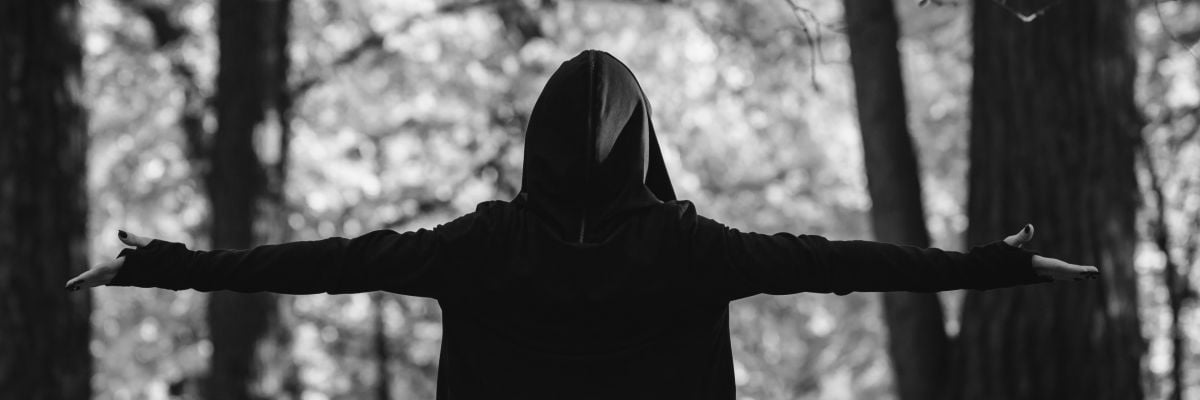
Beneath the silly and superficially shocking noise of modern Halloween celebrations lies a chilling testimony to the reality of the hallowed ones venerated on the eve of All Saints Day, and the Blessed Sacrament to which they were so devoted. The day is celebrated by profoundly misguided souls who attack the Eucharist, often diabolically validating that what even many Catholics think is merely symbolic bread is actually God truly present—body, blood, soul, and divinity.
When they convene their blasphemous Black Masses, Satanists don’t seek the mere wafers, wine, and grape juice used at Protestant churches. They want the Eucharistic Real Thing, obtainable only from a Catholic church. And thus, even though many Christians view Catholicism as blasphemous because of what the Church teaches about the sacrifice of the Mass (CCC 1365-67), the devil’s genuine devotees provide a compelling counter witness, diabolically affirming Catholic dogma in their infernal rituals. Hence the term Black Mass.
“The reality of Black Masses requires Catholics to become as reverentially protective of Jesus in the Holy Eucharist as Satan worshipers are irreverently intent on profaning Him,” says Father Roger Landry, a priest of the Diocese of Fall River, Massachusetts.
“Priests and deacons, extraordinary ministers of Holy Communion and, indeed, all the faithful must become more vigilant to ensure Jesus in the Eucharist isn’t shoplifted,” adds Fr. Landry, “by ensuring that he is consumed immediately upon reception, especially when someone receives Holy Communion in the hand.”
Black Masses have reportedly been on the increase in the last decade, with notorious events in Cambridge, (2014), Oklahoma City (2016) and this summer in Ottawa. Leaders of the “Satanic Temple,” who engage in these demonic rituals, argue they are simply rebelling against spiritual delusion, not serving as the devil’s shock troops.
“We describe the Satanic Temple as ‘non-theistic,’ and take care to make clear that we do not advocate a belief in the supernatural,” said spokesman Lucien Greaves. “In the case of the satanic Black Mass, a ritual can be a deeply personally significant declaration of independence from oppressive superstition.”
The claim to religious unbelief seems disingenuous, as the overwhelming number of atheists oppose religion without invoking Satan in formal rituals. In addition, arguing for their group’s non-belief appears convenient, because Satanic Temple members in other contexts describe themselves as religionists in order to get tax-exempt status.
“What we’re doing right now is asserting our constitutional right, our religious right. . . [W]e are Satanists practicing our satanic faith,” Nicholas Marc of Ottawa says. “All we’re going to be doing . . . is practicing our faith, in private, on our own terms, like every other religion does.”
And they use a host, consecrated or not, in a diabolical inversion of the Holy Mass.
Indeed, the one thing no one disputes is that Satanists choose to mock the Catholic Mass, not Protestant services, in another backhanded validation of the Church from those most aligned with the devil. Still, whether or not you believe in the devil and his demons, invoking them can be hazardous to your health, as Blessed Bartolo Longo and many others have lived to tell.
Often, when the devil and his devotees bring their malice into public view, God and his Church are glorified in faithful responses to their hostile witness, whether via reverent Eucharistic processions at Harvard or exorcists’ gaining dramatic victory over the demonic. As the Catechism of the Catholic Church says,
Although Satan may act in the world out of hatred for God and his kingdom in Christ Jesus, and although his action may cause grave injuries—of a spiritual nature and, indirectly, even of a physical nature—to each man and to society, the action is permitted by divine providence which with strength and gentleness guides human and cosmic history. It is a great mystery that providence should permit diabolical activity, but “we know that in everything God works for good with those who love him” (395, citing Romans 8:28).
Extraordinary spiritual phenomena should jolt Catholics out of a lukewarm disposition, but, as Fr. Landry counsels, Satan is more than happy to lead the faithful to a cavalier attitude toward the sacred.
“The devil’s main guise is not to get people to dress in goat heads, facial makeup, black clothing and amulets, but rather to get us to distrust and disobey God,” he notes. “His stratagem is not to seduce multitudes to participate in occult rituals of Eucharistic sacrilege, but to entice us to receive Holy Communion unworthily or not at all.”
“If the devil sniggers over his success in duping people to disregard the privilege of encountering Jesus in the Mass,” says Fr. Landry, “he’s probably even happier in having hornswoggled so many of those who still practice into treating receiving Jesus in Holy Communion unworthily.
Fr. Landry adds that this spiritual complacency begins much closer to home: “While few ritually worship Satan, many unwittingly follow him. How pleased Satan must be that on any given Sunday the vast majority of Catholics have been hoodwinked into believing something else is more important than coming to be with Jesus at Mass.”
Concluding that “there needs to be a rebirth of taking Jesus in the Eucharist seriously, by showing up to be in his presence each Lord’s Day and by ensuring that one and others are receiving Him in a true communion of life and love,” Fr. Landry evokes the consistent teaching of the Church and the witness and wise counsel of the greatest saints in history.
This All Hallows Eve presents a wonderful opportunity to evangelize with a joyful counter-witness to what the day has become in our confused culture. I’ve been encouraged by the movement in recent years by Catholic parents to dress their children in costumes depicting worthy saintly heroes as they go door-to-door. Maybe even “St. Michael the Archangel” might be persuaded to give candy to your neighborhood’s trick-or-treaters, saying “God bless you” and “Happy Halloween.”



